INTRODUCTION
Probiotics are human-associated microorganisms that are consumed either with food or as a supplement to improve the health of the host. In the scientific field, probiotics are defined as live microorganisms that, when administered in adequate amounts, confer a health benefit on the host (FAO/WHO, 2002; Fijan et al., 2019; Mazziotta et al., 2023). Probiotics may contain a variety of microorganisms, yet Lactobacillus and Bifidobacterium bacteria, primarily isolated from fermented dairy products and the fecal microbiome, are the most prevalent (Cunningham et al., 2021; Fijan, 2014; Singh et al., 2022). Other bacteria, including Escherichia coli, Leuconostoc, Enterococcus, Streptococcus, Pediococcus, and Streptococcus, can be used as probiotics. It is also possible to use yeasts like Saccharomyces boulardii. However, a variety of novel potential probiotic taxa are expected in the future (Blaabjerg et al., 2017; Gorreja and Walker, 2022; Ren et al., 2022).
The prevention of antibiotic-associated diarrhea, such as that brought on by Clostridium difficile, is one of the potential health benefits of probiotics. Along with safeguarding premature babies against necrotizing enterocolitis and sepsis (Aceti et al., 2015; Goldenberg et al., 2013; Jayaram et al., 2016; Morgan et al., 2020; Rao et al., 2016). Furthermore, probiotics can be used to treat irritable bowel syndrome (Williams et al., 2010), management of depression (Lyte, 2011), Alzheimer’s (de Rijke et al., 2022), periodontal diseases (Zhang et al., 2022), and induction or maintenance of remission in ulcerative colitis (Gheisary et al., 2022; Soni et al., 2018). Moreover, probiotics are suggested as adjunctive therapy to avoid COVID-19. Indeed, Darbandi et al. (2021) reported that probiotics significantly increase the plasma levels of cytokines and reduce the titer of viruses and the incidence and duration of respiratory infections (Wang et al., 2022).
Probiotics can also be found in vaginal capsules, chewable tablets for gum health, cosmetic products like skin creams and tampons, and dietary supplements, beverages, and medications (Fijan et al., 2019; Reid, 2015; Senok, 2009). The U.S. Food and Drug Administration (FDA) regulates a probiotic product as a dietary supplement, a food ingredient, or a drug depending on its intended use. Many probiotics are sold as dietary supplements, which do not require FDA approval before they are marketed (Degnan, 2008). Although there is still a lack of knowledge regarding the minimum effective concentrations, it is widely agreed that probiotic products should have a minimum concentration of 106 CFU/ml (Kechagia et al., 2013). The selection of the best probiotic might be a difficult process. Yet, a prior study found that disease specificity, strain specificity, and mode specificity are the key factors affecting probiotics’ efficacy (Sniffen et al., 2018). Thus, a significant issue in the Middle East is the lack of regional regulations for the labeling of probiotic products. A previous study performed in the United Arab Emirates showed the importance of developing guidelines for labeling these probiotic products, as well as for the use of structure/function statements and health claims, as the majority of these products are consumed without the direct supervision of healthcare providers (HCPs) (Senok, 2009). Hence, the product label should provide the full name of the probiotic strain or strains and the minimum live count of probiotic strains throughout the product’s shelf life. Sweileh et al. (2016) retrieved from SciVerse and Scopus, 2,817 original and review papers on probiotics in pediatrics that had been published internationally between 1994 and 2014 and examined them. During the study period, there was a roughly 90-fold increase in the number of research on probiotics in pediatrics. Parallel to this, sales of probiotic products have lately increased globally, from 23.1 to 31.3 billion USD (Talib et al., 2018). However, it was also found that all of these studies occurred in developed countries and only a few studies had been done on the marketing of functional foods in developing countries like Jordan (Altamimi et al., 2019; Soni et al., 2018). However, little is known about how active healthcare professionals view the application and effectiveness of probiotics. Information on the frequency with which healthcare professionals use probiotics or the patient suggestions they make is scarce. Scientific research highlights the changes in drug perception according to medical knowledge and clinical practice (Abdelmalek et al., 2021; Bdair et al., 2022). As more patients start incorporating these supplements into their daily medical regimens, it is crucial to understand how familiar and what they think about probiotic-based treatments are from the perspective of (HCPs). This study aimed to explore and elaborate on the probiotic knowledge, attitude, and practice of the (HCPs) in Jordan in comparison with their colleagues in the Middle East.
METHOD
Study setting
During the 3 months from May to August 2020, a cross-sectional survey with an online questionnaire was conducted. It was distributed via email and social media. The target population for this study was HCPs who are currently employed in the Middle East (Jordan, Syria, Lebanon, Palestine, Iraq, Egypt, Gulf, and Morocco), hospitals, universities, and private sectors. Participants were free to respond.
Reliability and validity of the questionnaire
The test–retest approach was employed to evaluate the reliability of the questionnaire. Ten pilot questionnaires were distributed to healthcare professionals, including dietitians, physicians, dentists, pharmacists, and psychiatrists, who were asked to complete them and provide input on the questionnaire’s design. The same questionnaire was provided to the same respondents 10 days later. The correlation coefficient between the first and second scores was computed. The questions were designed based on the study objects following the advice of a survey of previous research (Ababneh et al., 2020; Fijan et al., 2019; Oliver et al., 2014; Soni et al., 2018; Williams et al., 2010).
Study design
The investigator-designed survey consisted of five sections: demographic questions, knowledge assessment questions, concerns regarding probiotics, practice, and attitudes characteristics. Demographic questions included country, age, gender, educational qualification, and faculty majors (medical doctors, dentistry, nutrition, pharmacy, and psychology). The knowledge assessment section is comprised of questions related to the definition, mechanism of action, health effects, sources, risk factors, types, usage, and availability of probiotic products in the Arabian market. After determining whether an answer was correct (coded as 1) or incorrect (coded as 0), the total points were divided into three categories: 0–13 (poor), 14–26 (fair), and 27–40. (good). The third and fourth sections were used to assess participants’ practice of probiotics and the limitation of use. Section 5 had 7 statements performed to assess participants’ attitudes toward probiotics. On a five-point scale, subjects were asked to check off any of the five potential answers, ranging from strongly agree to do not agree. The average time to complete the survey was 7 minutes. Al-Balqa Applied University’s Institutional Review Board has approved the study.
Descriptive statistics were performed for all variables; mean, standard deviation, and frequencies were calculated to describe distributions and differences in knowledge, perceptions, and use of probiotics and prebiotics. Statistical analysis for the continuous and categorical variables was performed using the chi-square test. For the significance of the results, the analysis of variance test was used to examine if the variants reject the Null hypothesis. Pearson’s correlation coefficient was implemented to measure the statistical relationship between continuous and independent variables. A p-value of less than 0.05 was considered significant for statistical significance. The Statistical Package for Social Sciences software (version 20, Chicago, IL) was used for data processing and analysis.
RESULTS
Demographic characteristics
HCPs from several Arab countries, including Jordan, Syria, Lebanon, Palestine, Iraq, Egypt, Gulf, and Morocco, responded to this survey. Table 1 demonstrates the demographics of the HCPs who participated in this study; 299 participants started the survey, whereas only 269 participants were considered valid as they completed all of the questionnaire’s sections. In total, 156 (58%) respondents were females and 113 (42%) were males. The participant specialties were categorized into five groups, medical doctors (87, 32.2%), clinical pharmacists (72, 26.8%), followed by dietitians (45, 16.7%), dentists (34,12.6%), and others (78, 29%). The majority of respondents (112, 41.6%) had more than 10 years of experience working as a health professional, followed by those with 1–5 years of experience (69, 25.7%) and participants with between 6 and 10 years of experience (63, 23.4%). The smallest proportion of the respondents (25, 9.3%) had less than 1 year of experience working as a health professional. Regarding the age groups, 61 (22.7%) of participants were less than 20 years, 114 (42.4%) between 20 and 30, 66 (24.5%) between 30 and 40, 18 (6.7%) between 40 and 50, and about 10 (3.7%) more than 60 years old. Respondents were drawn from the following regions: Jordan (161, 59.9%), Arabian Gulf Region (59, 21.9%), and others (49, 18.2%).
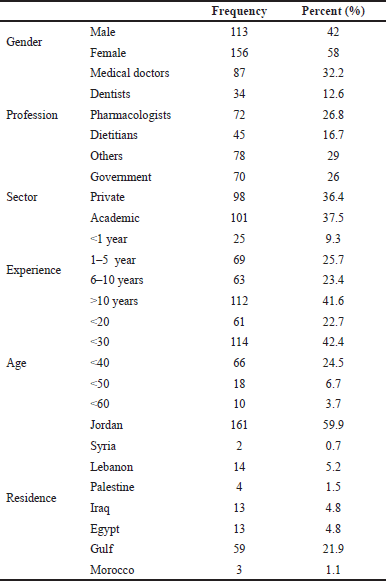 | Table 1. Demographic characteristics of the participants, (n = 269). [Click here to view] |
Knowledge of HCPs about probiotics
Knowledge in this study refers to understanding the proper definition of probiotics, the name of the strains, effectiveness, types of the products, and usage. The results showed that 13.3% of HCPs had good knowledge of probiotics, 70.4% of HCPs had fair knowledge, and 16.3% of HCPs had poor knowledge when answering the survey questions (Fig. 1).
The p-values less than 0.05 (p < 0.05) were considered significant. Only the specialization of HCPs was substantially correlated with their knowledge score when examining the association between demographic factors and knowledge scores (p = 0.004).
Respondent’s knowledge of microbial species including probiotic strains
Respondents were then asked to select the microorganism species from a list they believed to include probiotic strains. The list contained the following: S. boulardii, Enterococcus faecium, Lactobacillus acidophilus, Bacillus subtilis, Lactobacillus rhamnosus, E. coli, Mycobacterium avium, and Bifidobacterium bifidum. As shown in Figure 2, L. acidophilus (69%), B. bifidum (62%), and L. rhamnosus (57%) were the most recognizable species of bacteria containing probiotic strains, respectively. Although they are less well recognized, S. boulardii (24%), B. subtilis (21%), E. faecium (19%), and E. coli Nissle 1917 (19%) were also properly listed by the respondents. Mycobacterium avium was the only species on the list lacking probiotic strains, and 18% of respondents chose it incorrectly.
The respondents’ knowledge about probiotic strains also differed considerably among the various groups of HCPs (Fig. 3). Bacillus subtilis was the most recognizable microbial species with probiotic strains among all of the health provider groups. The vast majority of health providers in all groups except dietitians and clinical pharmacists recognized this species as including probiotic strains. All health provider groups are considerably less familiar with the yeast species S. boulardii, which contains probiotic strains. Contrarily, M. avium does not contain any probiotic strains and was surprisingly recognized by medical doctors (54%), clinical pharmacists (38.9%), dietitians (38.8%), and dentists (20%) that this species could contain probiotic strains.
Reasons for taking probiotics
Most respondents agreed that probiotics should be used to treat cases of diarrhea (88.5%) and constipation, reduce bloating (65.9%), and treat asthma (56.3%). Less than 25% of the respondents thought that taking probiotics could be good for patients with lactose intolerance, dermatological problems, depression or mood disorders, carcinoma, oral health, and urinary tract infection (UTI).
Practice patterns
When HCPs were asked if they had ever used probiotics, 57.8% answered “no.” The majority of HCPs that used probiotics were dietitians (69.4%). The lowest percentage was found among clinical pharmacists (24.4%). Respondents were also asked if they had ever recommended probiotic use to a patient; about 48.1% of respondents said “yes” (Fig. 4). We also analyzed this question separately for the groups of the specialty (Fig. 5). The majority of medical providers (74.1%) and dietitians (71.4%) recommend probiotic use to their patients.
Products with probiotics
Most probiotic products that had ever been used personally or advised by HCPs to their patients were either yogurts (31.1%) or supplements (26.7%). In contrast, probiotic products such as cosmetic products, vaginal capsules or creams, oral health products, and tampons were poorly addressed, as summarized in Figure 6.
The limitation of use
The majority of HCPs (71.1%) stated “lack of information regarding available probiotics products” as the primary barrier to probiotic use or recommendation, followed by “probiotics supplements are not regulated by the FDA” (28.9%). 15.8% of HCPs identified that “probiotics are pricey,” indicating that some of them had financial obstacles.
Respondents’ attitudes and understanding of probiotics
In response to questions about clinical indications and their attitude toward prescribing probiotics, our results reveal that the concept of probiotics was affected by gender. Our results show that females were more common with the concept of probiotics than males (p= 0.025) In addition, the residency was significant for the knowledge about probiotics as the residents in Jordan were more aware than those in other regions, as the p-value was 0.047. Age has provided significance to the correlation with the fact that probiotics should be taken continuously daily for better results, as the p-value was 0.0006. In this context, our data also demonstrated that the younger ages were not familiar with the consumption and dosage of probiotics.
Females were more familiar with the knowledge of probiotics than males as they were significantly familiar with not all dairy products containing probiotics and had better knowledge about the therapeutic benefits of probiotics. Moreover, females revealed that the benefits of probiotics are proven by clinical research, and they are aware that there are various strains of probiotics and each strain has a specific role and function. Females also showed a more positive attitude toward probiotics when they were asked if they wanted to learn more about probiotics as a treatment method and whether there was a need to include more information about probiotics subjects in university classes. Further, females significantly believe that pharmaceutical institutions in the Arab world should play a greater role in terms of disseminating information on the use of probiotics and show a more positive attitude toward attending or participating in workshops related to the use of probiotics. Respondents’ opinions on whether pharmaceutical institutions in the Arab world should play a greater role in terms of disseminating information on the use of probiotics significantly correlated with gender, age, specialty, and years of experience factors as p-value were 0.02, 0.013, 0.013, and 0.002, respectively.
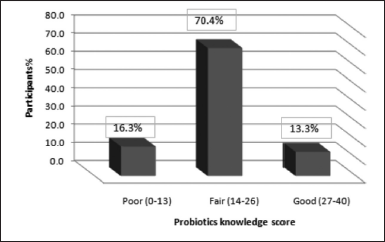 | Figure 1. Respondents’ knowledge of probiotics. [Click here to view] |
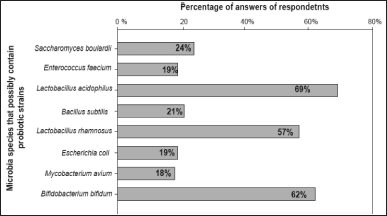 | Figure 2. Respondents’ knowledge of microbial species that possibly have probiotic strains. [Click here to view] |
 | Figure 3. Respondents’ knowledge of microbial species with possible probiotic strains according to the health profession. [Click here to view] |
 | Figure 4. Use of probiotics among health providers. [Click here to view] |
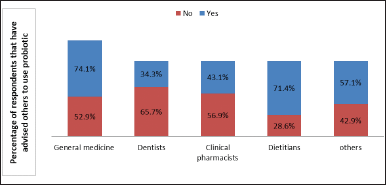 | Figure 5. Recommend regarding the use of probiotics to patients by profession. [Click here to view] |
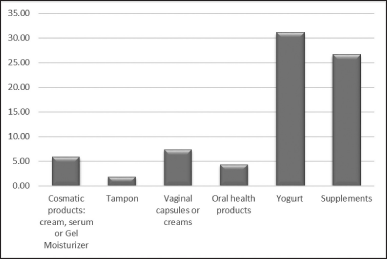 | Figure 6. Respondents’ attitudes toward probiotic products that they used. [Click here to view] |
Table 2 summarizes the correlation of HCPs’ responses to the questions assessing their probiotic knowledge, attitudes, and understanding. Lactobacillus acidophilus was the most well-known probiotic by the Jordanian society p < 0.0001. Most Jordanian HCP have reported that they have prescribed or advised the usage of probiotics at least once in their life (p = 0.019). Most of the correspondents have agreed, regardless of their nationality or their resident area, that there should be an effective role for the government in distributing knowledge about probiotics (p = 0.08). The probiotic concept was more common in females than males, as the value was (p = 0.025). Females were more familiar with the sources of probiotics and how they can acquire the product and they reported that these products are not only in the diary. Additionally, they reported that they have a passion for gaining more knowledge about the uses of probiotics and what are the types predominantly found (p = 0.001). On the other hand, how is the proper usage of probiotics was mostly correlated with the university age and they would be students in university (p < 0.05). According to specialty, significant results were noted in the pharmacist category about probiotics more than other medical staff as they reported that they know what probiotics are and what they use (p < 0.001). Years of experience did not affect much on the knowledge of probiotics; on the contrary, we found a lack of knowledge with the increase of time.
Furthermore, after applying a multilingual linear regression model for the factors, results demonstrate that gender and specialty were significantly important for the knowledge, attitude, and practice of probiotics among the study population (Table 3).
DISCUSSION
This cross-sectional study investigated the probiotic knowledge, attitudes, and practice of medical providers in Jordan, Syria, Lebanon, Palestine, Iraq, Egypt, the Gulf, and Morocco. The fact that only 269 respondents (n = 269) completed the survey was a significant drawback of our research. This could be explained by the fact that several HCPs felt they lacked the necessary training to respond to the survey’s questions adequately. Due to anonymity, responses to anonymous surveys cannot be traced back to the respondent.
Only 13.3% of responders to the current study had good probiotics knowledge, and that knowledge was statistically different among other health profession groups included in the analysis (p = 0.004). Only about 26.5% of dietitians correctly defined probiotics, strains, effectiveness, types, and usage; by contrast, the corresponding percentages for medical doctors, clinical pharmacists, dentists, and other practitioners were 12.6%, 17.1%, 5.6%, and 14.8%, respectively (data not shown). These findings are consistent with a prior study that revealed Brescia University students had little knowledge of probiotics (Hekmat and Koba, 2006). A similar study in Jordan reported that only 35.6% of Jordanian HCPs had a good knowledge score regarding probiotics (Ababneh et al., 2020). Notably, regardless of the professional group, about 69.2% of the respondents correctly define probiotics as “live microorganisms, that when administered in adequate amounts, confer a health benefit to the host.” This result was similar to that reported in other studies, where over 70% and 65.6% of the health providers answered correctly to the definition of probiotics (Amarauche, 2016; Fijan et al., 2019). On the other hand, about 22% of the respondents in these studies incorrectly defined probiotics and 8.5% stated that they did not know the probiotic.
Regarding the knowledge of the probiotic strains, respondents were asked to select the probiotic species from the provided list of microorganisms. The list included S. boulardii, E. faecium, L. acidophilus, B. subtilis, L. rhamnosus, E. coli, M. avium and B. bifidum. The L. rhamnosus, L. acidophilus, and B. bifidum are the most well-known probiotics by the respondents. These results are comparable to those of other studies demonstrating the Lactobacillus and Bifidobacterium genera as the most well-known, commonly used probiotics (Guiné and Silva, 2016; Hill et al., 2014). The only yeast species listed in our survey that contains probiotic strains, S. boulardii, was recognized by 24% of surveyed HCPs, while B. subtilis was recognized by 21%. Moreover, E. faecium PTA 5844 and E. coli Nissle 1917 are known strains considered natural probiotics and inhabitants of the gastrointestinal tract (GI). These were only well recognized by less than 20% of respondents. On the other hand, M. avium, an opportunistic pathogen with no known probiotic strains, was unfortunately recognized by 18% of respondents as probiotics. However, these results show that the respondents’ knowledge about probiotic strains differed considerably among the various groups of health providers. For example, while B. subtilis was recognized by most health providers in all groups except dietitians and clinical pharmacists, M. avium was surprisingly acknowledged by over 5% of medical doctors. Worth to mention that according to specialty, a significant result was noted in the pharmacist category more than other medical staff. Indeed, pharmacists majorly reported that they know what probiotics are and what they use, and the p-value was 0.001, as shown in Table 2. These data are in context with previous results (Fijan et al., 2019) that also revealed well knowledge of pharmacists over medical doctors and other related categories.
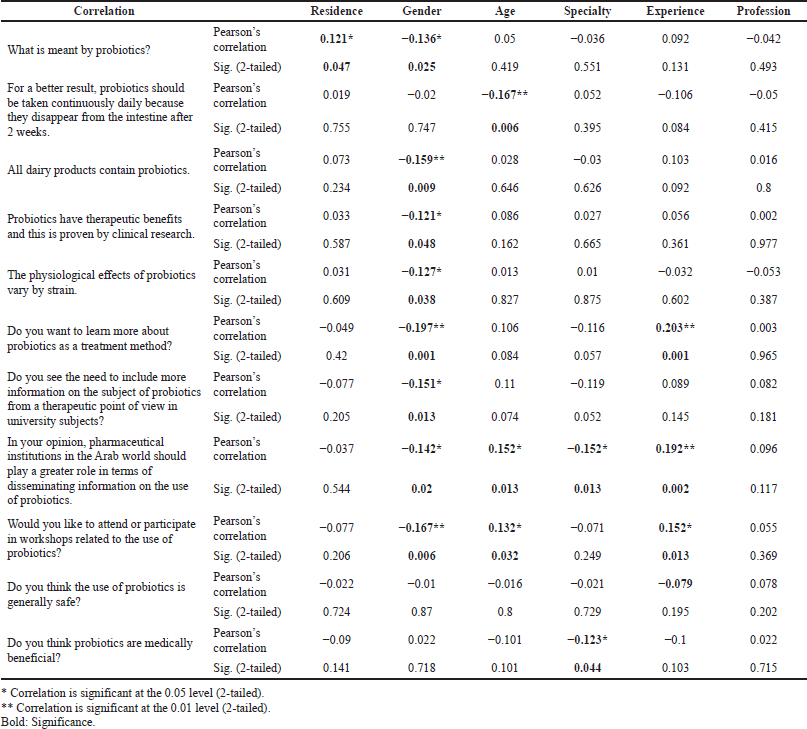 | Table 2. Association between HCPs’ status and knowledge of probiotics. [Click here to view] |
Moreover, a large number of respondents were aware of the use and benefits of probiotics in managing diarrhea (88.5%) and reducing bloating (65.9%). Similar to the results in Hasosah et al. (2021), 86% reported that probiotics were used to improve digestion and gastrointestinal immunity. In addition, a previous study reported that 98% of participants thought that probiotics may be used to treat digestive disorders or their symptoms (Williams et al., 2010). However, respondents reported that probiotics are of scientific interest for intestinal pathology. Their effects are varied with multiple clinical problems such as gastroenteritis, Helicobacter pylori infection, asthma, lactose intolerance, dermatological problems, depression or mood disorders, carcinoma, oral health, and UTI (Jordan et al., 2015; Li et al., 2022; Sniffen et al., 2018; Soni et al., 2018; Stavropoulou and Bezirtzoglou, 2020). Because of various reasons, many of our respondents use and recommend the use of probiotics. In this context, surprisingly, pharmacists who knew most probiotics were the least likely to use probiotics and the second group most to recommend probiotics after dentists. Our results revealed that probiotics were recommended to patients by 74.1% of medical doctors and 71.4% of dietitians, respectively. This is predicted given the numerous published large-scale research on the effectiveness of probiotics in GI illnesses. These findings were consistent with those of Oliver et al. (2014), who found that although 55% of respondents knew the advantages of probiotic use, they did not encourage using them. Unexpectedly, just 43.1% of pharmacists recommended probiotics as a supplement. These data revealed that the specialty of the tested group plays a crucial role in their attitude. Many respondents lack knowledge of products other than yogurts and supplements that have probiotic effects, such as cosmetic products, vaginal capsules, or creams. In addition, it is crucial to ensure the recommendation that HCPs should have the permeability to access scientific information directly from probiotic companies (Fijan et al., 2019). Furthermore, the full name of the probiotic strain(s) and the minimum live count of the probiotic strains throughout the shelf life of the products have to be clearly stated on each product’s label as per Jordan Food and Drug Administration instructions. In a study on European pediatric HCPs, Pettoello-Mantovani et al. (2019) reported that 91% (n = 1,120) of the sample answering their questionnaire expressed the need for HCPs to be educated about probiotics. Surprisingly, in their study, they reported that dietitians had the least training regarding probiotics compared to other HCPs (Pettoello-Mantovani et al., 2019).
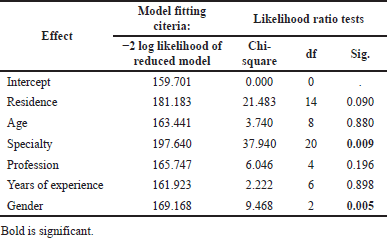 | Table 3. Likelihood ratio tests. [Click here to view] |
In the current study, it was demonstrated that females had favorable opinions toward the usage of probiotics over males’. Ababneh et al. (2020) stated that this is connected to the fact that women are often more interested in matters relating to nutrition and dietary supplements. Oliver et al. (2014) also reported similar findings. Furthermore, among all professional groups, only dietitians had a positive attitude toward the use of probiotics, which is reasonable considering their type of work; in addition, most of the people who are working in the nutrition field are females. Opposing results were presented by Pettoello-Mantovani et al. (2019), who reported that European dietitians are more likely to not recommend probiotics containing formulae or food (44.7% of dietitians in their sample compared to as low as 22%–29% of other pediatric HCPs in Europe). Pettoello-Mantovani et al. (2019) reported that the higher the training a HCP gets, the more likely they are to prescribe probiotic use.
CONCLUSION
Most HCPs had a limited level of knowledge of probiotics, despite the positive attitudes and positive practices toward probiotics. Therefore, the role of HCPs in giving informed and objective advice on probiotics has largely increased. Our findings demonstrate that gender and specialty were significantly important for the knowledge, attitude, and practice of probiotics. In this context, enhancing healthcare practitioners’ knowledge using focused learning programs and workshops would be recommended since the majority were interested in knowing more about probiotics.
LIMITATIONS OF THE STUDY
This study has potential limitations. The sample size was insufficient to represent all the Arab countries for statistical measurements. This is could be due to time constraints. In fact, a 3-month Internet survey was administered from May to August 2020. It is important to note that most countries were under lockdown due to COVID-19 when we launched the questionnaire, and HCPs were extremely busy.
ACKNOWLEDGMENTS
The authors would like to express our gratitude to all survey respondents who took the time to complete our online questionnaire.
AUTHOR CONTRIBUTIONS
Alfawares was a contributor in conceptualization, study design, methodology, project administration, data curation and writing the original draft and approving final version of manuscript. Abu Rayyan contributed to data analysis and editing. Fararjeh contributed to data analysis and editing. Seder was a contributor in final editing. All authors read and approved the final manuscript.
FINANCIAL SUPPORT
There is no funding to report.
CONFLICTS OF INTEREST
The authors declare that there are no conflicts of interest.
ETHICAL APPROVALS
This study does not involve experiments on animals or human subjects.
PUBLISHER’S NOTE
This journal remains neutral with regard to jurisdictional claims in published institutional affiliation.
DATA AVAILABILITY
Data files are available upon request.
REFERENCES
Ababneh M, Elrashed N, Al-Azayzih A. Evaluation of Jordanian healthcare providers’ knowledge, attitudes, and practice patterns towards probiotics. Expert Rev Pharmacoecon Outcomes Res, 2020; doi:10.1080/14737167.2019.1609354
Abdelmalek S, AlEjielat R, Rayyan WA, Qinna N, Darwish D. Changes in public knowledge and perceptions about antibiotic use and resistance in Jordan: a cross-sectional eight-year comparative study. BMC Public Health, 2021; 21(1):1–12; doi:10.1186/s12889-021-10723-x
Aceti A, Gori D, Barone G, Callegari ML, Di Mauro A, Fantini MP, Indrio F, Maggio L, Meneghin F, Morelli L, Zuccotti G, Corvaglia L, Italian Society of Neonatology. Probiotics for prevention of necrotizing enterocolitis in preterm infants: systematic review and meta-analysis. Italian J Pediatr, 2015; doi:10.1186/s13052-015-0199-2
Altamimi E, Abu Hamed A, Alrejjal K, Fanni A. A249 knowledge of Jordanian medical students about probiotics and their health usage. J Can Assoc Gastroenterol, 2019; doi:10.1093/jcag/gwz006.248
Amarauche CO. Assessing the awareness and knowledge on the use of probiotics by healthcare professionals in Nigeria. J Young Pharm, 2016; 8(1):53–5; doi:10.5530/jyp.2016.1.12
Bdair OA, Bdair IA, Gogazeh E, Al-Fawares O, Alwadi M, Badaineh R, Al-Tarawneh F. A cross-sectional survey of knowledge, attitude, and practices regarding influenza vaccination among Jordanians aged 18–64 with chronic diseases. Turk J Pharm Sci, 2022; doi:10.4274/tjps.galenos.2022.61798
Blaabjerg S, Artzi DM, Aabenhus R. Probiotics for the prevention of antibiotic-associated diarrhea in outpatients—a systematic review and meta-analysis. Antibiotics, 2017; doi:10.3390/antibiotics6040021
Cunningham M, Azcarate-Peril MA, Barnard A, Benoit V, Grimaldi R, Guyonnet D, Holscher HD, Hunter K, Manurung S, Obis D, Petrova MI, Steinert RE, Swanson KS, van Sinderen D, Vulevic J, Gibson GR. Shaping the future of probiotics and prebiotics. Trends Microbiol, 2021; 29:667–85; doi:10.1016/j.tim.2021.01.003
Darbandi A, Asadi A, Ghanavati R, Afifirad R. The effect of probiotics on respiratory tract infection with special emphasis on COVID-19: a periodic review during 2010-2020. Int J Infect Dis, 2021; doi:10.1016/j.ijid.2021.02.011
de Rijke TJ, Doting MHE, van Hemert S, De Deyn PP, van Munster BC, Harmsen HJM, Sommer IEC. A systematic review on the effects of different types of probiotics in animal Alzheimer’s disease studies. Front Psychiatry, 2022; 13:1–17; doi:10.3389/fpsyt.2022.879491
Degnan FH. The US Food and Drug Administration and probiotics: regulatory categorization. Clin Infect Dis, 2008; doi:10.1086/523324
FAO/WHO. Guidelines for the evaluation of probiotics in food (FAO Food and Nutrition Paper 85). Food and Agriculture Organization of the United Nations and World Health Organization Group Report, London, UK; Ontario, Canada, 2002.
Fijan S. Microorganisms with claimed probiotic properties: an overview of recent literature. Int J Environ Res Public Health, 2014; doi:10.3390/ijerph110504745
Fijan S, Frauwallner A, Varga L, Langerholc T, Rogelj I, Lorber M, Lewis P, Bržan PP. Health professionals’ knowledge of probiotics: an international survey. Int J Environ Res Public Health, 2019; doi:10.3390/ijerph16173128
Gheisary Z, Mahmood R, Harri Shivanantham A, Liu J, Lieffers JRL, Papagerakis P, Papagerakis S. The clinical, microbiological, and immunological effects of probiotic supplementation on prevention and treatment of periodontal diseases: a systematic review and meta-analysis. Nutrients, 2022; 14(5); doi:10.3390/nu14051036
Goldenberg JZ, Ma SSY, Saxton JD, Martzen MR, Vandvik PO, Thorlund K, Guyatt GH, Johnston BC. Probiotics for the prevention of Clostridium difficile-associated diarrhea in adults and children. Cochrane Database Syst Rev, 2013; doi:10.1002/14651858.CD006095.pub3
Gorreja F, Walker WA. The potential role of adherence factors in probiotic function in the gastrointestinal tract of adults and pediatrics: a narrative review of experimental and human studies. Gut Microbes, 2022; 14(1):1–27; doi:10.1080/19490976.2022.2149214
Guiné RPF, Silva ACF. Probiotics, prebiotics and synbiotics. In Functional foods: sources, health effects and future perspectives. 2016; doi:10.1201/b15561-2
Hasosah M, Qurashi M, Balkhair A, Alzahrani Z, Alabbasi A, Alzahrani M, Alnahdi W, Shafei S, Bafaqih M, Khan M. Knowledge, attitudes, and understanding of probiotics among pediatricians in different regions of Saudi Arabia. BMC Med Educ, 2021; 21(1):1–7; doi:10.1186/s12909-021-02499-w
Hekmat S, Koba L. Fermented dairy products: knowledge and consumption. Can J Dietetic Pract Res, 2006; 67(4):199–201; doi:10.3148/67.4.2006.199
Hill C, Guarner F, Reid G, Gibson GR, Merenstein DJ, Pot B, Morelli L, Canani RB, Flint HJ, Salminen S, Calder PC, Sanders ME. Expert consensus document: the international scientific association for probiotics and prebiotics consensus statement on the scope and appropriate use of the term probiotic. Nat Rev Gastroenterol Hepatol, 2014; 11(8):506–14; doi:10.1038/nrgastro.2014.66
Jayaram P, Chatterjee A, Raghunathan V. Probiotics in the treatment of periodontal disease: a systematic review. J Indian Soc Periodontol, 2016; doi:10.4103/0972-124X.207053
Jordan D, Johnson N, Thomas L. Probiotics in primary care: a survey of health professionals. Pract Nurs, 2015; 26(11):550–4; doi:10.12968/pnur.2015.26.11.550
Kechagia M, Basoulis D, Konstantopoulou S, Dimitriadi D, Gyftopoulou K, Skarmoutsou N, Fakiri EM. Health benefits of probiotics: a review. ISRN Nutr, 2013; doi:10.5402/2013/481651
Li X, Wang Q, Hu X, Liu W. Current status of probiotics as supplements in the prevention and treatment of infectious diseases. Front Cell Infect Microbiol, 2022; 12:1–12; doi:10.3389/fcimb.2022.789063
Lyte M. Probiotics function mechanistically as delivery vehicles for neuroactive compounds: microbial endocrinology in the design and use of probiotics. BioEssays, 2011; doi:10.1002/bies.201100024
Mazziotta C, Tognon M, Martini F, Torreggiani E, Rotondo JC. Probiotics mechanism of action on immune cells and beneficial effects on human health. Cells, 2023; 12(1); doi:10.3390/cells12010184
Morgan RL, Preidis GA, Kashyap PC, Weizman AV, Sadeghirad B; McMaster Probiotic, Prebiotic, and Synbiotic Work Group. Probiotics reduce mortality and morbidity in preterm, low-birth-weight infants: a systematic review and network meta-analysis of randomized trials. Gastroenterology, 2020; doi:10.1053/j.gastro.2020.05.096
Oliver L, Rasmussen H, Gregoire MB, Chen Y. Health care provider’s knowledge, perceptions, and use of probiotics and prebiotics. Topics Clin Nutr, 2014;
Pettoello-Mantovani M, Çullu Çoku?ra? F, Vural M, Mestrovic J, Nigri L, Piazzolla R, Giardino I, Conoscitore M, Namazova-Baranova L. Pilot study for the understanding and use of probiotics by different paediatric healthcare professionals working in different European countries. Italian J Pediatr, 2019; 45(1):1–11; doi:10.1186/s13052-019-0648-4
Rao SC, Athalye-Jape GK, Deshpande GC, Simmer KN, Patole SK. Probiotic supplementation and late-onset sepsis in preterm infants: a meta-analysis. Pediatrics, 2016; doi:10.1542/peds.2015-3684
Reid G. The growth potential for dairy probiotics. Int Dairy J, 2015; doi:10.1016/j.idairyj.2015.04.004
Ren Z, Hong Y, Huo Y, Peng L, Lv H, Chen J, Wu Z, Wan C. Prospects of probiotic adjuvant drugs in clinical treatment. Nutrients, 2022; 14(22):1–16; doi:10.3390/nu14224723
Senok AC. Probiotics in the Arabian Gulf region. Food Nutr Res, 2019; doi:10.3402/fnr.v53i0.1842
Singh RP, Shadan A, Ma Y. Biotechnological applications of probiotics: a multifarious weapon to disease and metabolic abnormality. Probiotics Antimicrob Proteins, 2022, 14(6):1184–210; doi:10.1007/s12602-022-09992-8
Sniffen JC, McFarland LV, Evans CT, Goldstein EJC. Choosing an appropriate probiotic product for your patient: an evidence-based practical guide. PLoS One, 2018; 13(12):1–22; doi:10.1371/journal.pone.0209205
Soni R, Tank K, Jain N. Knowledge, attitude and practice of health professionals about probiotic use in Ahmedabad, India. Nutr Food Sci, 2018; doi:10.1108/NFS-02-2017-0032
Stavropoulou E, Bezirtzoglou E. Probiotics in medicine: a long debate. Front Immunol, 2022; 11:1–20; doi:10.3389/fimmu.2020.02192
Sweileh WM, Shraim NY, Al-Jabi SW, Sawalha AF, Rahhal B, Khayyat RA, Zyoud SH. Assessing worldwide research activity on probiotics in pediatrics using Scopus database: 1994-2014. World Allergy Organ J, 2016; doi:10.1186/s40413-016-0116-1
Talib MA, Rayis OA, Konozy EHE, Salih MA. Effect of gum Arabic (Prebiotic) on physicochemical and organoleptic properties of yogurt (Probiotic). In Gum Arabic: structure, properties, application and economics. 2018; doi:10.1016/B978-0-12-812002-6.00014-2
Wang B, Zhang L, Wang Y, Dai T, Qin Z, Zhou F, Zhang L. Alterations in microbiota of patients with COVID-19: potential mechanisms and therapeutic interventions. Signal Transduct Target Ther, 2022; 7(1); doi:10.1038/s41392-022-00986-0
Williams MD, Ha CY, Ciorba MA. Probiotics as therapy in gastroenterology: a study of physician opinions and recommendations. J Clin Gastroenterol, 2010; doi:10.1097/MCG.0b013e3181d47f5b
Zhang Y, Ding Y, Guo Q. Probiotic species in the management of periodontal diseases: an overview. Front Cell Infect Microbiol, 2022; 12:1–15; doi:10.3389/fcimb.2022.806463